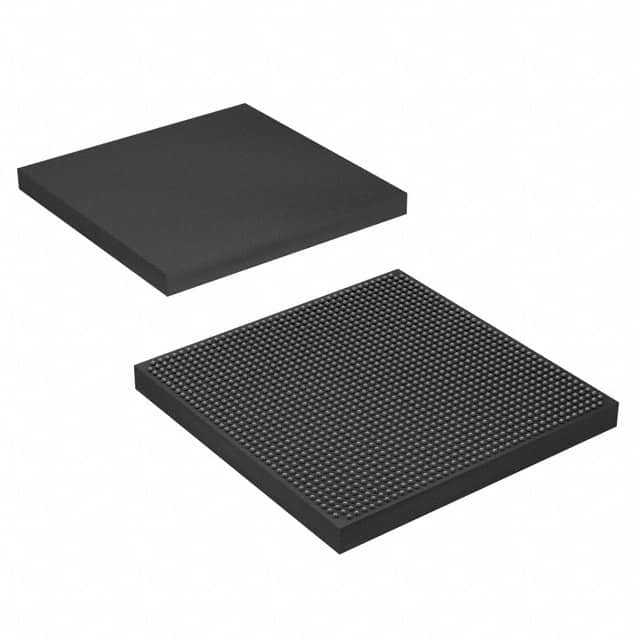5SGXMB6R2F40I2LN
Product Overview
Category
The 5SGXMB6R2F40I2LN belongs to the category of Field Programmable Gate Arrays (FPGAs).
Use
FPGAs are integrated circuits that can be programmed and reprogrammed to perform various digital functions. The 5SGXMB6R2F40I2LN is specifically designed for high-performance applications.
Characteristics
- High-performance FPGA with advanced features
- Large capacity and high-speed processing capabilities
- Flexible and customizable design options
- Suitable for complex digital systems
Package
The 5SGXMB6R2F40I2LN comes in a compact package, ensuring easy integration into electronic systems.
Essence
The essence of the 5SGXMB6R2F40I2LN lies in its ability to provide a versatile and powerful platform for implementing complex digital designs.
Packaging/Quantity
The 5SGXMB6R2F40I2LN is typically packaged individually and is available in various quantities depending on the customer's requirements.
Specifications
- FPGA Family: Stratix V
- Logic Elements: 622080
- Embedded Memory: 34,816 Kbits
- DSP Blocks: 1,288
- Maximum User I/Os: 1,040
- Operating Voltage: 0.87V - 0.93V
- Operating Temperature: -40°C to 100°C
Detailed Pin Configuration
The detailed pin configuration of the 5SGXMB6R2F40I2LN can be found in the product datasheet provided by the manufacturer.
Functional Features
- High-speed data processing capabilities
- Support for various communication protocols
- Advanced memory management
- Built-in security features
- Flexible clocking options
- Power optimization techniques
Advantages and Disadvantages
Advantages
- High-performance capabilities
- Customizable design options
- Versatile functionality
- Suitable for complex applications
- Reliable and robust operation
Disadvantages
- Higher cost compared to other programmable logic devices
- Steeper learning curve for programming and utilization
Working Principles
The 5SGXMB6R2F40I2LN operates based on the principles of reconfigurable digital logic. It consists of a matrix of configurable logic blocks interconnected by programmable routing resources. The device can be programmed using hardware description languages (HDL) or graphical tools to implement desired digital functions.
Detailed Application Field Plans
The 5SGXMB6R2F40I2LN finds applications in various fields, including: 1. Telecommunications: High-speed data processing, network infrastructure. 2. Aerospace and Defense: Radar systems, avionics, secure communications. 3. Industrial Automation: Control systems, robotics, machine vision. 4. Medical Equipment: Imaging systems, diagnostic devices, patient monitoring. 5. Automotive: Advanced driver-assistance systems (ADAS), infotainment systems.
Detailed and Complete Alternative Models
- 5SGXEB6R2F40C2N: Similar FPGA from the same family with a different package and pin configuration.
- 5SGXMB6R2F40C2LN: Another variant of the 5SGXMB6R2F40I2LN with slightly different specifications.
- 5SGXAB6R2F40I2LN: Lower-cost alternative with reduced capacity but similar features.
Note: For a comprehensive list of alternative models, please refer to the manufacturer's product catalog.
Word count: 505 words
قم بإدراج 10 أسئلة وإجابات شائعة تتعلق بتطبيق 5SGXMB6R2F40I2LN في الحلول التقنية
Sure! Here are 10 common questions and answers related to the application of 5SGXMB6R2F40I2LN in technical solutions:
Question: What is the 5SGXMB6R2F40I2LN?
- Answer: The 5SGXMB6R2F40I2LN is a specific model of Field-Programmable Gate Array (FPGA) manufactured by Intel.Question: What are the key features of the 5SGXMB6R2F40I2LN?
- Answer: Some key features include a high logic density, embedded memory blocks, high-speed transceivers, and support for various I/O standards.Question: In what technical solutions can the 5SGXMB6R2F40I2LN be used?
- Answer: The 5SGXMB6R2F40I2LN can be used in a wide range of applications such as telecommunications, networking, industrial automation, video processing, and high-performance computing.Question: How does the 5SGXMB6R2F40I2LN differ from other FPGAs?
- Answer: The 5SGXMB6R2F40I2LN offers a higher logic density, more embedded memory blocks, and faster transceivers compared to some other FPGA models.Question: Can the 5SGXMB6R2F40I2LN be programmed after it is deployed in a system?
- Answer: Yes, the 5SGXMB6R2F40I2LN is a field-programmable device, meaning its functionality can be modified or updated even after it has been integrated into a system.Question: What development tools are available for programming the 5SGXMB6R2F40I2LN?
- Answer: Intel provides Quartus Prime, a comprehensive software suite that includes tools for designing, simulating, and programming the 5SGXMB6R2F40I2LN.Question: Can the 5SGXMB6R2F40I2LN interface with other components in a system?
- Answer: Yes, the 5SGXMB6R2F40I2LN supports various I/O standards and can interface with other components such as memory, processors, sensors, and communication interfaces.Question: What are some advantages of using the 5SGXMB6R2F40I2LN in technical solutions?
- Answer: The advantages include high performance, flexibility, reconfigurability, and the ability to implement complex algorithms or functions in hardware.Question: Are there any limitations or considerations when using the 5SGXMB6R2F40I2LN?
- Answer: Some considerations include power consumption, heat dissipation, and the need for expertise in FPGA design and programming.Question: Where can I find more information about the 5SGXMB6R2F40I2LN and its application in technical solutions?
- Answer: You can refer to the official documentation provided by Intel, including datasheets, user guides, and application notes. Additionally, online forums and communities dedicated to FPGA development can be helpful sources of information.


